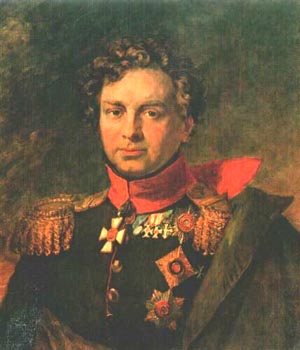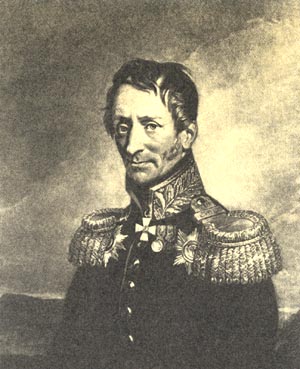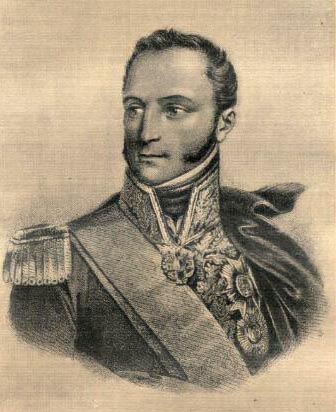September, 4-5 (August,23-25)
(From L.G.Beskrovny "The Borodino Battle", Moscow, 1971, P.A.Zhilin "The Patriotic War Of 1812",
D.Bantish-Kamensky "The Biographies of The Russian Generalissimos And Field-Marshals", vol. 3, Moscow, 1840 )
 General A.Gorchakov by Dow |
Kutuzov must do one of the following:
- To retreat more quickly and leave Konovnitsyn to the mercy of fate. But in this case Napoleon, after defeating Konovnitsyn, would follow the Russians even faster, and catch up with them somewhere near Mozhaysk, forcing Kutuzov to give battle there.
- Or, Kutuzov had to do that he had originally planned: to stop near the Kolotsky Monastery, and fortify this position by absorbing the rear-guard of Konovnitsyn into his main forces - and wait for the enemy here.
Napoleon came to the Shevardino redoubt at night on September 5th, before Bagration's troops had completely left. Some smaller Russian detachments were still in and around it. The defenders repulsed several French cavalry attacks, But shortly, two French infantry divisions and 3 regiments of the 3rd division drove back Neverovsky's division that defended the approaches, and assaulted the Shevardino redoubt itself.

The Shevardino Battle
The Russian troops, knowing death was inevitable, met the much larger French forces with bayonets, shouting "Hurrah!" They all were killed.
 General Sivers by Dow |
After the fierce all-day battle (September 5th), Kompan's division captured the redoubt (about 7 p.m.), and an hour later Morand's division occupied the village of Shevardino.
The Russian artillerymen had continued firing until the French burst into the retrenchments, and though they could have escaped, they fought hand-to-hand until they were all bayoneted near their guns.
That night, understanding the danger of the premature appearance of Napoleon near the main Russian positions, Bagration sent reinforcements to Neverovsky (whose division had been almost fully destroyed). And he, himself, came to Shevardino with the 2nd grenadier and a part of the Composite grenadier divisions. Bagration joined the 27th Infantry Division and personally led them to the attack. This attack was supported by the cavalrymen of the Glukhovsky and Malorossiysky cuirassier regiments from the Division of General Duka from the left, and by the Kharkovsky and Cherhigovsky dragoon regiments from the right. The Russian cavalry crushed the three French columns that were hurrying to the redoubt and seized the hills near Doronino village. They also captured three enemy guns and destroyed three more. At the same time, two more guns were captured not far from Alexinka village.
The Russian grenadiers rushed to the attack too. They overran the French and had retaken their redoubt at about 9 p.m. The French counter-attacked but were beaten back. Darkness came but the battle continued. Kutuzov ordered that this redoubt be held until the 2nd Western Army was completely settled into its main defensive position, so it was not until almost midnight that Bargation got the order to stop resisting and retreat from Shevardino to positions on the left flank of the Russian army.
It was very late when this battle ended, and the French, with far greater forces, could not understand why the battle lasted so long.
Finally there was silence at Shevardino; in the deep darkness the French returned to Valuevo and Gridnevo, stumbling over dead bodies covering the approaches to the redoubt.

A.Caulaincourt |
On the evening of September 5th, the Russian rear-guard under the command of General Konovnitsyn was attacked by the French again near the monastery at the Kolocha river, and thrown back to Borodino.
Later that evening, Caulaincourt came to Napolen, sitting in his tent, and told him "We have not taken a single captive"
Napoleon was shocked and asked if it could really be true that the Russians had their minds made up to win or die. He slept little that night. Sometimes it appeared to him that the Russian camp-fires were dying out. Sometimes he thought he heard a distant uproar from the Russian camp. He was still apprehensive: "Could the Russians escape again under the cover of night?" He considered the nature of the battle at Shevardino and decided that the future general battle would be mostly an artillery duel, not a bayonet struggle. Bayonets and rifles would play a secondary role.
At daybreak of September 6th, the Emperor, with his retinue and Marshals, went to examine the positions. He did not alight from his horse the whole day, watching the Russian camp, with its constant movement and noise. At mid-day the French found out that Kutuzov was riding around his troops too, and the icon of the The Smolenskaya Virgin (taken from Smolensk) was carried around the Russian camp. This continued until evening.
The same day Napoleon went to the Shevardino redoubt, perhaps to check the report he had received before. He asked one general from his retinue who took part in the combat at Shevardino,
"How many captives did you take yesterday?"This short talk was reported by many witnesses, and by the officers of the Life-Guard Cossack regiment, who together wrote the history of their regiment based upon memoirs of witnesses.
"They don't surrender at all, sir!"
"Don't surrender? Well, so we will kill them!"
said Napoleon, and rode away.